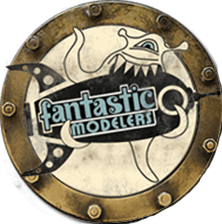Giving life to a model as the Imperial Star Destroyer from Star Wars cannot be sufficiently achieved by just assembling the model “out of the box”, it is necessary to light it up. I’ve already talked about lighting up a model on Fantastic Modelers but never using optical fiber. Optical fiber in scale modeling allows to realize a multitude of small spotlights on a model surface. These spotlights can represent dashboards lights or small portholes, depending on the scale. Here of course, they represent the countless portholes of the Star Destroyer.
Scooping out the obstructing sections

A model is rarely meant to receive optical fibers during the assembly. The first job is often to scoop out obstructing sections to allow the fiber to go through. To do that I use a small drill equiped with a grindstone.
Getting the optical fiber
The simplest and cheapest solution is to use an “illuminated fountain”. You can find one on every general website shop. The fibers are not calibrated, wich is both an advantage and a disadvantage :

- you can find large diameter optical fiber (0.7 mm) or small ones (0.4 mm) depending on what you want to do.
- The drilling diameter must be adjusted, sometime the hole is too large, sometimes not enough…
Some people could prefer to use calibrated optical fiber instead. I find this solution too expensive, this fiber is of higher quality, designed for telecommunication. Simple optical fiber is no more than… fishing wire ! Telecommunication ones uses physical principles too complicated for this use.
Using optical fiber in scale modeling just to guide the light on a model surface doesn’t need such a technology.
Building the optical fiber harness
You must start by select a harness. It must be glued with white glue and a LED is taped at the base. For the Stardestroyer, all LEDs are white.



The fibers drive most of the light at the end. Some light can leak at the base but that’s fine if your model is “lightproof”.
Drilling the holes
It’s the longest stage. Of course, a small diameter drill bit (0.5 mm most of the time) is to be used. Well, when I say “one”, in fact you will have to use 3 or 4 given that they are easily breakable.
The difficulty of this operation depends on the model material. With resin, no problem : the drilled resin forms a very fine sawdust (easily breathable and a little carcinogenic…). With plastic (PVC or polystyren), it’s more complicated : the plastic tends towards melting because of th heat and forms heavy clusters at the base of the drilling bit. It has to be cleaned up very often.
Passing the fibers through the holes
The last step is quite simple, the optical fibers must be passed through the holes. It can be difficult with non-calibrated fiber. I usually cut the fiber in bevel to facilitate the introduction.

Using optical fiber in scale modeling : final result
After several dozen hours of work, here is the fiber-equipped upper hull of the stardestroyer :







COMMENTS